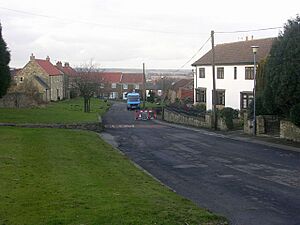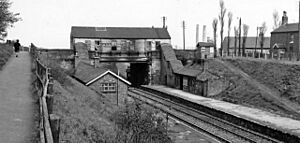Brandon, County Durham facts for kids
Quick facts for kids Brandon |
|
|---|---|
 North End, Brandon |
|
| OS grid reference | NZ240396 |
| Civil parish |
|
| Unitary authority | |
| Ceremonial county | |
| Region | |
| Country | England |
| Sovereign state | United Kingdom |
| Post town | DURHAM |
| Postcode district | DH7 |
| Police | Durham |
| Fire | County Durham and Darlington |
| Ambulance | North East |
| EU Parliament | North East England |
| UK Parliament |
|
Brandon is a village in County Durham, England. It's located a short distance southwest of Durham. Long ago, Brandon was a small farming area. But it grew a lot when coal mines, and later factories for coke and fireclay, opened up. For a long time, Brandon was one of the bigger villages in the Brancepeth area.
Contents
Brandon's Past: A Look at History
Brandon has a long history. It used to be a special kind of estate called a 'manor' in the medieval times. Powerful families, like the Nevilles, owned it. Other nearby places had big houses for wealthy families too.
What Happened After the Northern Rising?
After a big event called the Northern Rising in 1569, Queen Elizabeth I took control of Brancepeth Castle and its lands. These lands were managed by the Crown for a while.
Later, in the 1620s, King Charles I had to give these lands to the City of London to pay off his debts. The lands were then sold off to different people. However, Brandon manor stayed with its London buyer, a silk merchant named Edward Cropley. His family owned it until 1710. After that, it passed to the Earl of Shaftesbury's family, who kept it until the 1800s.
William Russell and the Land
In 1796, a man named William Russell, who owned coal mines, decided to stop mining. He used some of his money to buy and fix up Brancepeth Castle. He also tried to buy back as much of the old Brancepeth lands as he could.
In 1806, he bought the Brandon estate from the Earl of Shaftesbury for a lot of money. Later, Russell's granddaughter married into an Irish noble family. This is how the names Hamilton-Russell and the title Viscount Boyne became connected to the area.
How Brandon's Population Grew
Brandon's population changed a lot over the years. In 1801, about 522 people lived in Brandon and Byshottles. By 1811, it went down a bit to 435. Then, in 1851, it was 525.
But by 1881, the population had jumped to 10,850! And in 1891, it was 14,240. There was a small drop in the 1830s because workers who were rebuilding Brancepeth Castle moved away. The stone for the castle came from Brandon village. A road called Sawmills Lane was probably built to make it easier to move the stone.
Brandon's Industries: From Farms to Mines
For a long time, most people in Brandon worked in farming. Even those who leased the coal seams were often farmers too. Records show that in 1836, John Shaw was running a small coal pit. He used a 'whim-gin,' which was a machine often pulled by horses or a bull, to bring coal to the surface.
The Rise of Coal Mining
The area changed a lot in the 1850s. Factories and ironworks needed more and more coal and coke. So, business people came to Brandon to open new coal mines.
Brandon Colliery
A company from Newcastle called Straker and Love started Brandon Colliery. They dug the 'A' shaft in 1856 and the 'C' pit in 1860. By 1894, 1150 men and boys worked at this mine. They dug coal from the Hutton, Busty, and Brockwell seams. Brandon Pit house was dug in 1924. Coal mining at Brandon finally stopped on March 15, 1968.
Browney Colliery
Other companies also came to mine coal. Bell Brothers from Newcastle and Middlesbrough started digging at Browney Colliery in 1871. Coal was being brought up from three shafts by 1873. These shafts worked the Brockwell, Busty, and Hutton seams. The company was taken over by Dorman Long & Co. in 1923. In 1930, 625 people worked at this mine. Sadly, the pit closed in July 1938 because of flooding.
Littleburn Colliery
In North Brancepeth, a coal company got the right to mine at Littleburn Colliery. They dug the engineer shaft to the Busty seam in 1870. Then, they dug the merchant shaft to the Brockwell in 1871. In 1931, the company went out of business. The pit was reopened by Bearpark Coal and Coke Co. on a smaller scale. They worked the Busty seam until flooding from the River Browney forced it to close in December 1950.



